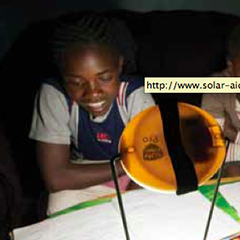It’s hard to imagine, but there are 600 million Africans living without connection to the electricity grid. However, a new social enterprise is taking an approach to this fundamental problem that could bring light to the darkest corners rural Africa. PES investigates…
As highlighted by President Obama at the launch of his Power Africa Initiative, over 110 million households have no access to electricity. Many rely on dangerous kerosene lamps to fulfil their most basic energy need – clean light. SolarAid show how small PV powered lights are creating a pico-pathway that can transform energy access.
SolarAid provide an alternative to kerosene by building long-term markets for pico-solar products. A pico-solar light is a compact portable device that uses PV to produce up to 10watts of power. Combined with advanced batteries and LED bulbs it simply charges in the day to give out clean, safe light at night; and these lights don’t require infrastructure, maintenance or use costly fuel to run. Seeding and building pico-solar markets across Africa will cost 0.015 per cent of the amount required to provide universal access to energy on the continent, and give hundreds of millions access to safe, secure energy for lighting – all within the next few years. Technological advancements have led to the development of lights ideally suited to the rigours of rural life and pico-solar products offer families an opportunity to invest in their own energy solutions, minimising the cost to governments and stakeholders. In the words of a solar light owner from Narok in Kenya, “we always have free sunshine”.
While it may not provide the full energy access of a grid system, this market-based approach will not only release the latent potential of a generation of solar entrepreneurs, but provide jobs and opportunity for young people whose ingenuity and innovation will drive the sector forward.
Providing access to safe solar energy
SolarAid believe they have ‘cracked the code’ for distributing solar lights – allowing them to reach the people who need them most. Getting lights to rural areas and creating trust in new technology is a complex and expensive task when there is little in the way of retail or transport infrastructure. In order to address this challenge, SolarAid founded a social enterprise called SunnyMoney to sell lights rather than give them away.
The impact is getting greater by the day. As local communities see the incredible effect of the lights, more and more are choosing to invest in solar energy. SunnyMoney has now sold over 600,000 solar lights, reaching around 2.85 million people, and its 600 per cent yearly growth rate is set to build the basis for a thriving long-term market. The displacement of an estimated 900,000 kerosene lamps has created around $40 million in annual fuel savings by base of the pyramid consumers, with research indicating these have been diverted to nutritious food, education and small enterprise. The solar lights meanwhile have created eight million extra hours of lighting in off-grid communities, increasing study-time and reducing indoor air pollution; and with it the risk of pneumonia, tuberculosis and eye infection. On an environmental level this has not only led to the elimination of 55,000 tonnes of CO2 but a tonne of black carbon which has a far more immediate effect. One kg of black carbon produces as much positive forcing within a few weeks as 700kg of CO2 does during 100 years.
SolarAid’s entire approach is built around collaboration. SunnyMoney purposefully aims to catalyse mass adoption of pico-solar technology and de-risk the industry for others to join. In order to reach its goal of eradicating the kerosene lamp from the continent by 2020, SolarAid shares its market-building knowledge with key stakeholders, working with organisations such as the International Finance Corporation and UNICEF to improve access to energy in complex developing world environments. All sales revenue collected by SunnyMoney is reinvested back into market build or used to fund pilots which improve access to solar technology, such as pioneering ‘pay as you go’ systems and Light Libraries in schools.



























